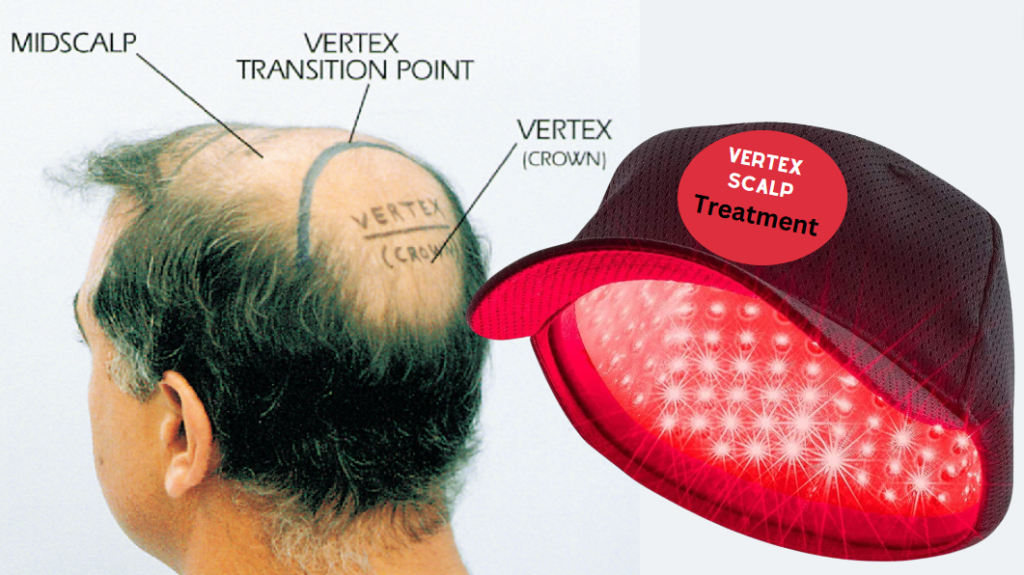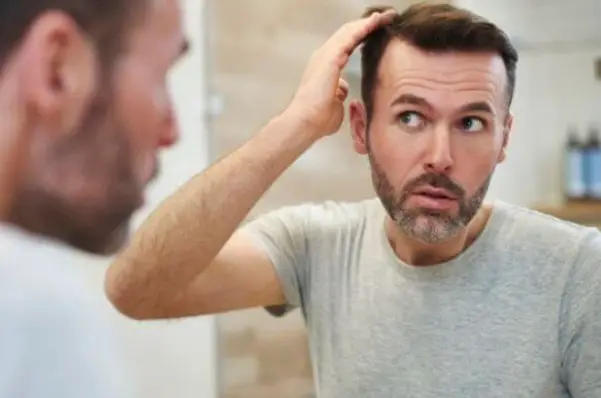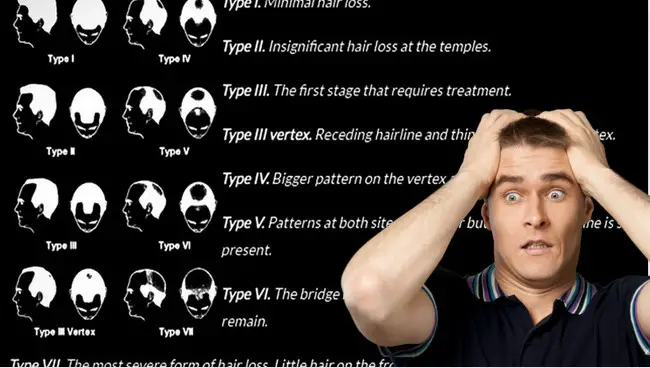Hair loss can be a distressing experience, especially when it occurs in the easily noticeable vertex scalp area. The crown of our heads, often referred to as the vertex, is prone to various types of hair loss affecting both men and women.
This blog post provides an in-depth overview of vertex scalp hair loss, its causes, and available treatment options that can help regain lost confidence caused by thinning crown or balding issues.
Whether you’re seeking medical advice or simply looking for tips on maintaining a healthy scalp, this comprehensive guide has got you covered.
Did you know that the scalp is made up of four main areas?
Yes, These include the frontal region, mid scalp, vertex transition zone, and crown.
Male pattern baldness is the most common cause of hair loss in men and follows a pattern on the scalp. For men with androgenic alopecia, the first area of the scalp where hair loss is noticeable is the frontal region.
The mid-scalp region or mildscap, located behind the frontal region, experiences hair loss in advanced stages of male pattern baldness. The vertex transition zone, found between the mid-scalp region and the crown, is important for creating density and reducing the appearance of baldness at the back of the head. Lastly, the crown is located at the back of the head and is also known as the vertex, according to specialists.
Key Takeaways
- Vertex scalp hair loss can affect both men and women, with the most common cause being male pattern baldness or androgenetic alopecia.
- Diagnosing the underlying cause of vertex scalp hair loss is important in determining the appropriate treatment option, which may include medication, laser therapy, hair transplant surgery or platelet-rich plasma therapy.
- In addition to medical treatments, maintaining a healthy lifestyle by eating a balanced diet rich in vitamins and minerals that promote healthy hair growth, using gentle hair care products, avoiding tight hairstyles that pull on the hair, protecting your scalp from sun damage and managing stress can help prevent or slow down vertex scalp hair loss.
- Seeking professional advice from a healthcare provider or specialist before embarking on any treatment regimen for vertex scalp hair loss is crucial for early detection and intervention.
So, What Vertex Scalp Is?
Vertex scalp is the area at the highest point on the back of the head, which often experiences hair loss or thinning in both men and women.
Definition Of Vertex Scalp Hair Loss
Vertex scalp hair loss refers to the thinning and eventual balding that occurs in the crown, or highest point, of the head. This type of patterned hair loss commonly affects both men and women as they age, with genetics playing a significant role in its development.
In male-pattern baldness, for instance, vertex hair loss often starts as a circular area on the back of the head that gradually expands over time.
For example, one common cause of vertex scalp hair loss is Androgenic Alopecia or Male Pattern Baldness (MPB), which impacts millions of individuals worldwide. Understanding this particular type of alopecia allows us to explore various medical treatments available today that target balding specifically at the vertex area.
Additionally, being aware of other potential scalp conditions like folliculitis, inflammation or even tumors can help people take preventative measures and seek professional advice promptly if needed.
Prevalence Of Hair Loss In The Vertex Scalp Area
Hair loss in the vertex scalp area is a common concern for many individuals, affecting both men and women. In fact, male pattern hair loss often presents itself as thinning or bald spots on the frontal and vertex regions of the scalp.
Women are not immune to hair loss at the crown either, with female pattern hair loss occurring in roughly 30-40% of adult women. A well-known example is alopecia areata – an autoimmune disorder that can cause patchy hair loss across the entire scalp, including the vertex area.
Causes Of Hair Loss In The Vertex Scalp Area
Understanding the causes of hair loss in the vertex scalp area is crucial for determining the right course of action to address this issue. One common factor contributing to hair loss in this region is male pattern baldness, which stems from a combination of genetic predisposition and hormonal levels.
Women can also experience hair loss in the vertex scalp area due to androgenetic alopecia, though it typically manifests differently than in men. Female pattern hair loss tends to result in diffuse thinning across the top of the head rather than distinct bald areas on the crown.
It’s essential not only to recognize these various causes but also seek professional help when dealing with any form of significant hair loss that may be affecting your confidence and self-esteem.
What Does Top Vertex Mean?
Top vertex refers to the highest point on the scalp, often located at the crown of the head. Hair loss in this area is a common concern for both men and women, with patterned hair loss or androgenetic alopecia being a leading cause.
Male pattern baldness can lead to thinning hair on the crown of the head and even complete baldness. The Norwood Scale classifies male pattern baldness into several stages of balding crown, including stage 3 vertex or Norwood 3 vertex where there is significant hair loss on the top of the scalp.
Various treatment options are available for individuals experiencing top vertex hair loss, depending on their specific condition. Medications like minoxidil and finasteride may help slow down further hair loss while promoting some regrowth in certain cases.
Other solutions include surgical options like follicular unit extraction (FUE) or follicular unit transplantation (FUT), which involve transplanting healthy hairs from other areas of the scalp onto balding areas like those found at the top vertex.
What Is Crown Vertex?
The crown vertex is the highest point on the scalp, located at the back of the head. It is also commonly referred to as just “the crown” or “vertex.” For men experiencing male pattern baldness, this area can be particularly prone to hair loss and thinning.
The Norwood scale is a classification system used by doctors to identify and track male pattern baldness in its different stages. When hair thins or falls out from the crown vertex area, it can create a distinctive horseshoe-shaped pattern that’s easily recognizable.
Hair transplantation surgery is one treatment option available for those seeking to restore lost hair in this area.
What Is The Normal Of A Vertex?
The “normal” of a vertex refers to the natural density and thickness of hair in this area of the scalp. Generally, people have thicker hair at the vertex compared to other areas of the scalp due to its central location on top of the head.
However, factors such as genetics, age, hormonal changes, medications, and lifestyle habits can impact how much hair grows in this area. It is important to note that some degree of hair loss or thinning may be considered normal as people age or experience hormonal changes.
However, if hair loss is excessive or occurs suddenly, it may be a sign of an underlying condition that requires medical attention.
For example: My dermatologist explained to me during my consultation that although women typically have less visible male pattern baldness than men do since female hormone protects them up until menopause but not always., women with Female pattern baldness often experience progressive loss from frontal-vertex regions which could lead one woman needing more grafts than another even though they are experiencing similar stages based on Norwood Scale because every individual’s regular vertex varies by their genetic makeup.
You will like to read:
- Normal Crown Vs Balding Crown | What’s the Difference!
- Early Stages of Balding Crown
- Receding Hairline Stages
- How to Stop Balding at The Crown
- Bald Crown: How to Fix It – When Spot It
Diagnosis And Treatment Of Vertex Scalp Hair Loss
Doctors can diagnose vertex scalp hair loss by examining the scalp and conducting a medical history review, blood tests, or a scalp biopsy; treatment options might include minoxidil, finasteride, dutasteride, hair transplant surgery or platelet-rich plasma therapy, and consider using red light therapy hats.
Diagnosis Of Hair Loss In The Vertex Scalp Area
If you are experiencing hair loss in the vertex scalp area, it is important to seek professional advice for proper diagnosis. The diagnostic process typically involves a thorough examination of the scalp and hair characteristics by a specialist, and may include additional tests such as blood work or a scalp biopsy.
It is essential to determine the underlying cause of hair loss, which can range from genetic factors like male pattern baldness to autoimmune disorders or nutritional deficiencies.
Once an accurate diagnosis has been made, appropriate treatment options can be suggested based on individual needs and preferences.
Red Light Therapy Hat
One of the newer treatments for hair loss that is becoming increasingly popular is red light therapy. This non-invasive treatment involves using a special hat that emits low-level laser light to stimulate hair growth and improve overall scalp health.
Red light therapy has been shown to increase blood flow, reduce inflammation, and promote collagen production in the scalp. It’s also been found to be effective for treating conditions like folliculitis, dandruff, psoriasis, and eczema on the vertex or crown area of the head.
Another interesting fact about red light therapy is its ability to prevent damage caused by UV rays or harmful chemicals found in hair products/treatments.
Medical And Surgical Treatment Options
As someone experiencing hair loss in the vertex scalp area, it is important to understand the options available for medical and surgical treatment. Here are some of the treatment options that you may want to consider:
1. Medications: Minoxidil and finasteride are commonly used medications for male pattern baldness. They work by promoting hair growth and preventing further hair loss.
2. Laser therapy: Low-level laser therapy (LLLT) for hair loss can be used to improve hair density, promote growth, and reduce inflammation in the scalp.
3. Crown hair transplant surgery: This is a surgical procedure that involves transferring hair follicles from one area of the scalp (the donor site) to another (the recipient site). The goal is to create a natural-looking hairline and restore fuller-looking hair.
4. PRF and PRP: Platelet-rich plasma (PRP) therapy involves injecting your own blood plasma into your scalp, which contains growth factors that can promote hair growth. PRF hair treatment offers a promising solution for addressing hair loss on the vertex scalp by harnessing the regenerative power of platelet-rich fibrin to stimulate natural hair growth and improve scalp health.
5. Scalp micropigmentation: A cosmetic tattooing procedure that uses pigments to create the appearance of fuller-looking hair.
It’s important to consult with a specialist who can assess your specific needs and recommend the best treatment option for you. Keep in mind that results may vary depending on individual circumstances, so it’s important to manage your expectations accordingly.
Why Does Minoxidil Say Vertex Only?
Minoxidil is a medication that stimulates hair follicles and can be applied directly to the scalp. It is an effective treatment for hair loss, especially in men with male pattern baldness.
The brand name Rogaine is the most popular form of minoxidil. One reason Rogaine says “vertex only” on its packaging is that it was specifically tested and FDA-approved for use at the vertex, or crown, of the scalp.
While it can also work on other areas of the scalp where hair loss occurs, this labeling ensures that users know where its efficacy has been clearly established through clinical trials.
Research suggests that minoxidil may stimulate blood flow to hair follicles and improve their function by increasing cell proliferation around the root area.
To summarize, minoxidil works well when applied correctly as directed by your doctor; however, while labeling might suggest “vertex-only,” this doesn’t mean it won’t work elsewhere – so don’t be afraid to test out different application points to see what regimen gives optimal results over time!
Lifestyle Changes To Prevent Or Slow Down Hair Loss
In addition to medical and surgical treatments, there are several lifestyle changes that can help prevent or slow down hair loss related to vertex scalp:
1. Eating a balanced diet rich in vitamins and minerals that promote healthy hair growth, such as iron, biotin, and vitamin D.
2. Avoiding tight hairstyles that pull on the hair, such as braids or ponytails.
3. Using gentle hair care products without harsh chemicals that can damage the hair and scalp.
4. Protecting the hair from sun damage with a hat or scarf when spending time outdoors.
5. Managing stress through relaxation techniques such as yoga or meditation.
6. Quitting smoking, which can restrict blood flow to the hair follicles and worsen hair loss.
7. Getting regular exercise to improve circulation and overall health.
By incorporating these lifestyle changes into your routine, you can help promote healthy hair growth at the vertex scalp area while also improving your overall well-being.
Tips For Maintaining A Healthy Vertex Scalp
To maintain a healthy Vertex scalp, it is important to practice proper hair care techniques, take nutritional supplements for healthy hair growth.
Proper Hair Care Techniques
As someone who is concerned about maintaining a healthy scalp and preventing hair loss, it’s important to develop good hair care habits. Here are some helpful tips for taking care of your scalp:
1. Wash hair regularly with a gentle shampoo to remove dirt and oil buildup that can clog hair follicles.
2. Use a conditioner to improve hair moisture and prevent breakage.
3. Avoid using hot water when washing your hair, as this can cause dryness and damage.
4. Limit the use of harsh styling products like gels, sprays, and dyes.
5. Massage your scalp regularly to improve blood circulation and stimulate hair growth.
6. Avoid pulling or twisting your hair too tightly as this can lead to damaging the hair root.
7. Protect your hair from environmental stressors such as sun rays by wearing a hat or using sunscreen.
By implementing these proper hair care techniques, you can promote a healthy scalp and decrease the risk of hair loss while also keeping your locks looking beautiful!
Nutritional Supplements For Healthy Hair Growth
Maintaining a healthy scalp and promoting hair growth can be enhanced by incorporating certain vitamins and minerals into your diet. Here are some recommended nutritional supplements to support healthy hair growth:
1. Biotin: Also known as vitamin H, biotin is essential for the formation of keratin, the protein that makes up hair, skin, and nails.
2. Vitamin E: A potent antioxidant, vitamin E can help improve blood circulation to the scalp and promote hair growth.
3. Iron: Iron deficiency anemia can cause hair loss, so ensuring adequate iron intake through diet or supplements can help prevent this.
4. Zinc: Zinc plays a crucial role in DNA production and cell division, which is important for healthy hair growth.
5. Vitamin D: Research suggests that low levels of vitamin D may be linked with hair loss, so it’s important to get adequate amounts either through sunlight exposure or supplements.
By including these vitamins and minerals in your diet or taking them as supplements, you can support healthy hair growth from the inside out.
Other Areas Of The Scalp Affected By Hair Loss
While the vertex of the scalp is a common area for hair loss, other regions of the scalp can also be affected. For example, midfrontal and temporal recession in men are also typical patterns associated with male pattern baldness.
Female pattern hair loss often presents as diffuse thinning across the top of the scalp rather than just at the crown or frontal region.
Aside from hair loss, there are many other conditions that can affect the health and appearance of your scalp. Scalp folliculitis is an infection that causes small red bumps around hair follicles on the head; inflammation, tumors, and cancer can also occur in this region.
Even though there are many issues related to this area, treating them effectively is possible through a combination of medical treatments and lifestyle changes such as improving nutrition intake or reducing stress levels which all have been proven effective methods for promoting healthy hair growth across all regions of your head!
You will like to read:
- How to Hide a Bald Spot on Crown
- Balding Crown But No Receding Hairline
- Hair Thinning At Crown Male Treatment
- How to Cover Up Bald Spots On Crown
Conclusion: Seeking Professional Advice For Vertex Scalp Hair Loss Treatment
Understanding the causes and treatment options for hair loss at the vertex scalp area is crucial to promoting healthy hair growth and regaining confidence. While there are various lifestyle changes, medical treatments, and surgical options available, it’s essential to seek professional advice from a healthcare provider or hair restoration specialist before embarking on any treatment regimen.
Early detection and intervention can greatly improve outcomes in managing pattern baldness or other scalp conditions affecting the vertex.
FAQs:
1. What causes hair loss on the vertex scalp?
Hair loss on the vertex scalp can be caused by a variety of factors such as genetics, aging, hormonal imbalances, medication use or certain medical conditions.
2. How is hair loss on the vertex scalp diagnosed?
A dermatologist will usually examine your hair and scalp to determine whether there are any visible signs of hair loss. They may also conduct blood tests and perform a biopsy to rule out underlying health issues that could be causing your condition.
3. What treatment options are available for hair loss on the vertex scalp?
There are several treatments available such as prescription medications like Minoxidil or Finasteride which can promote new growth and prevent further thinning of existing strands. Other options include surgical procedures like hair transplantation or micro-needling therapies.
4. Can lifestyle changes help with preventing or reversing hair loss on the vertex scalp?
Yes, making healthy lifestyle choices such as reducing stress levels, exercising regularly and maintaining a balanced diet rich in vitamins and minerals can help strengthen follicles while reducing inflammation that can lead to thinning over time if left unaddressed. Additionally using gentle shampoos free from harsh chemicals & protecting against UV rays exposure can slow down premature ageing of follicles thereby preserving existing strands longer!
Source URLs
- https://www.ncbi.nlm.nih.gov/books/NBK430924/
- https://www.betterhealth.vic.gov.au/health/conditionsandtreatments/patterned-hair-loss
- https://www.pennmedicine.org/for-patients-and-visitors/patient-information/conditions-treated-a-to-z/male-pattern-baldness
- AI Powered Bald Filter Online 2024: See Yourself with No Hair! - January 19, 2024
- Harklinikken Bad Reviews 2024: Analyzing Negative Feedbacks - January 18, 2024
- How to Get the Alex Eubank Hair | Step-By-Step Tutorial 2024 - January 18, 2024








